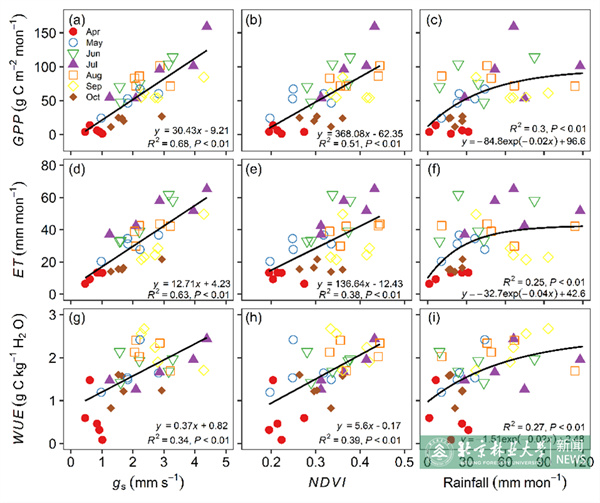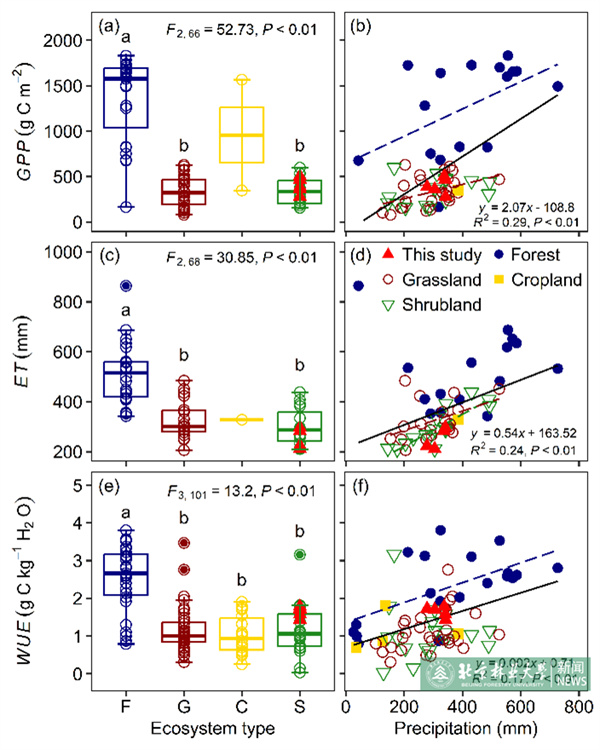Latest news
The team led by Professor Jia Xin from the School of Soil and Water Conservation at BFU has recently collaborated with researchers from Hohai University, Laurentian University in Canada, and the University of Saskatchewan. Their focus was on the black saxaul shrub ecosystem in the Maowusu Sandy Land. By employing a combination of long-term carbon and water flux measurements alongside machine learning techniques, they aimed to shed light on how vegetation and climatic factors impact Water Use Efficiency (WUE).
This research, enetiled "Vegetation factors and atmospheric dryness regulate the dynamics of ecosystem water use efficiency in a temperate semiarid shrubland" was featured in the Journal of Hydrology, a leading journal in hydrological studies. Dr. Mu Yanmei from the School of Soil and Water Conservation is the first author, with Professor Jia Xin as the corresponding author.

Ecosystem water use efficiency (WUE), a key indicator of the coupling between carbon and water cycle, has been widely used to quantify ecosystem responses to climate change. However, large uncertainties remain regarding the dynamics and driving factors of WUE in temperate semiarid shrublands. Using eddy-covariance measurements, we investigated the role of vegetation and hydrometeorological factors in affecting the temporal dynamics of WUE (GPP/ET, where GPP and ET represent gross primary production and evapotranspiration, respectively) over a semiarid shrubland of northern China during 2012–2016. Daily WUE was lower (<1.5 g="" c="" kg="">−1 H2O) in early-spring and late-autumn, and higher (2.0–7.0 g C kg−1 H2O) in summer months (June–August). Annual (January–December) WUE (1.43–1.78 g Ckg−1 H2O) was higher than most values previously reported for semiarid and arid shrubland ecosystems. Vegetation factors such as surface conductance (gs) and normalized difference vegetation index (NDVI) played a primary role in promoting monthly WUE during the warm and moist growing-season (April–October), while high vapor pressure deficit (VPD) and low root-zone soil water content (SWC) were key hydrometeorological factors that imposed constraints on daily WUE. Using both a machine-learning model and a data-binning algorithm, we showed that NDVI and VPD were the most important factors regulating WUE dynamics. Ongoing climate warming and increasingly frequent extreme events (e.g., droughts and heatwaves) are expected to induce high VPD, which in turn could reduce ecosystem WUE and undermine ecosystem carbon sequestration in semiarid shrublands. In addition, increasing vegetation cover in the studied area owing to continued restoration efforts is expected to enhance ecosystem WUE, and may result in stronger vegetation controls on WUE dynamics.


This study was supported by the National Natural Science Foundation of China (NSFC, No. U22A20504, 32071843, 32071842, 32101588, and 31901366), the National Key Research and Development Program of China (No. 2023YFF0805604), the National Ecosystem Science Data Center (No. NESDC20210101), the Natural Sciences and Engineering Research Council of Canada (No. RGPIN-201603960), the Fundamental Research Funds for the Central Universities (No. PTYX202324 and PTYX202325), and China Scholarship Council.
Paper link: https://doi.org/10.1016/j.jhydrol.2024.131644
Written by Mu Yanmei
Translated and edited by Song He
Reviewed by Yu Yangyang












